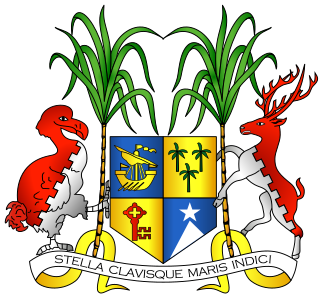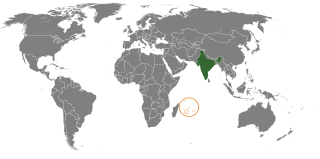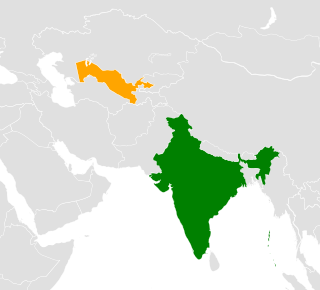The Ministry of External Affairs of India (MEA), also known as the Foreign Ministry, is the government agency responsible for the conduct of foreign relations of India. With the world's third largest military expenditure, largest armed force, fifth largest economy by nominal rates and third largest economy in terms of purchasing power parity, India is a regional power, a nuclear power, a nascent global power and a potential superpower. India has a growing international influence and a prominent voice in global affairs.

Mauritius has strong and friendly relations with the West, as well as with South Asian countries and the countries of southern and eastern Africa. It is a member of the World Trade Organization, the Commonwealth of Nations, La Francophonie, the African Union, the Southern Africa Development Community, the Indian Ocean Commission, COMESA, and the recently formed Indian Ocean Rim Association. Her Majesty Elizabeth II was the head of state of Mauritius.

The Association of Southeast Asian Nations is a regional intergovernmental organization comprising ten countries in Southeast Asia, which promotes intergovernmental cooperation and facilitates economic, political, security, military, educational, and sociocultural integration among its members and other countries in Asia.

The Asia-Pacific Economic Cooperation (APEC) is an inter-governmental forum for 21 member economies in the Pacific Rim that promotes free trade throughout the Asia-Pacific region. Following the success of ASEAN's series of post-ministerial conferences launched in the mid-1980s, APEC started in 1989, in response to the growing interdependence of Asia-Pacific economies and the advent of regional trade blocs in other parts of the world; it aimed to establish new markets for agricultural products and raw materials beyond Europe. Headquartered in Singapore, APEC is recognized as one of the highest-level multilateral blocs and oldest forums in the Asia-Pacific region, and exerts a significant global influence.

The South Asian Association for Regional Cooperation (SAARC) is the regional intergovernmental organization and geopolitical union of states in South Asia. Its member states are Afghanistan, Bangladesh, Bhutan, India, the Maldives, Nepal, Pakistan and Sri Lanka. SAARC comprises 3% of the world's area, 21% of the world's population and 4.21% of the global economy, as of 2019.

The economy of Asia comprises more than 4.5 billion people living in 49 different nations. Asia is the fastest growing economic region, as well as the largest continental economy by both GDP Nominal and PPP in the world. Moreover, Asia is the site of some of the world's longest modern economic booms, starting from the Japanese economic miracle (1950–1990), Miracle on the Han River (1961–1996) in South Korea, economic boom (1978–2013) in China and economic boom in India (1991–present).

The Indian Ocean Commission is an intergovernmental organization that links African Indian Ocean nations: Comoros, Madagascar, Mauritius, Réunion, and Seychelles. There are also five observers: China, India, Malta, the European Union and the Organisation internationale de la Francophonie.

The Bay of Bengal Initiative for Multi-Sectoral Technical and Economic Cooperation (BIMSTEC) is an international organisation of seven nations of South Asia and South East Asia, housing 1.5 billion people and having a combined gross domestic product of $3.5 trillion (2018). The BIMSTEC member states—Bangladesh, India, Myanmar, Sri Lanka, Thailand, Nepal and Bhutan —are among the countries dependent on the Bay of Bengal.

The Federation of Indian Chambers of Commerce and Industry (FICCI) is an association of business organisations in India. Established in 1927, on the advice of Mahatma Gandhi by GD Birla and Purshottamdas Thakurdas, it is the largest, oldest and the apex business organization in India. It is a non-government, not-for-profit organisation. FICCI draws its membership from the corporate sector, both private and public, including SMEs and MNCs. The chamber has an indirect membership of over 250,000 companies from various regional chambers of commerce. It is involved in sector-specific business building, business promotion and networking. It is headquartered in the national capital New Delhi and has a presence in 12 states in India and 8 countries across the world.
The Indian Ocean Research Group Inc. (IORG) is an Indian Ocean Regional academic network. The key objective of IORG is to initiate a policy-oriented dialogue, in the true spirit of partnership, among governments, industries, NGOs and communities, towards realizing a shared, peaceful, stable and prosperous future for the Indian Ocean region. IORG is currently based at the University of Adelaide, and Curtin University, Australia, but members come from all across the world.

The String of Pearls is a geopolitical theory on potential Chinese intentions in the Indian Ocean region (IOR). It refers to the network of Chinese military and commercial facilities and relationships along its sea lines of communication, which extend from the Chinese mainland to Port Sudan in the Horn of Africa. The sea lines run through several major maritime choke points such as the Strait of Mandeb, the Strait of Malacca, the Strait of Hormuz, and the Lombok Strait as well as other strategic maritime centers in Pakistan, Sri Lanka, Bangladesh, the Maldives, and Somalia.
The ASEAN–India Free Trade Area (AIFTA) is a free trade area among the ten member states of the Association of Southeast Asian Nations (ASEAN) and India. The initial framework agreement was signed on 8 October 2003 in Bali, Indonesia. and the final agreement was on 13 August 2009. The free trade area came into effect on 1 January 2010. India hosted the latest ASEAN-India Commemorative Summit in New Delhi on 26 January 2018. In the financial year 2017-18, Indo-ASEAN bilateral trade grew by almost 14% to reach US$81.3 billion. India's imports from ASEAN were valued at US$47.13 billion while its exports to ASEAN stood at US$34.2 billion.

The Bangladesh, China, India and Myanmar Economic Corridor (BCIM) is a proposed corridor connecting India and China through Myanmar and Bangladesh as a corridor.

India–Mauritius refers to the historical, political, economic, military, social and cultural connections between the Republic of India and the Republic of Mauritius. Connections between India and Mauritius date back to 1730, diplomatic relations were established in 1948, before Mauritius became independent state. The cultural affinities and long historical ties between the two nations have contributed to strong and cordial relations between the two nations. More than 68% of the Mauritian population are of Indian origin, most commonly known as Indo-Mauritians. India and Mauritius co-operate in combating piracy, which has emerged as a major threat in the Indian Ocean region and Mauritius supports India’s stance against terrorism.
The foreign policy of the Modi government concerns the policy initiatives made towards other states by the current government of India after Narendra Modi assumed the office of prime minister on May 26, 2014.

The Bangladesh, Bhutan, India, Nepal (BBIN) Initiative is a sub regional architecture of countries in Eastern South Asia, a subregion of South Asia. It meets through official representation of member states to formulate, implement and review quadrilateral agreements across areas such as water resources management, connectivity of power, transport, and infrastructure.
Foreign direct investment (FDI) in India is a major monetary source for economic development in India. Foreign companies invest directly in fast growing private Indian businesses to take benefits of cheaper wages and changing business environment of India. Economic liberalisation started in India in wake of the 1991 economic crisis and since then FDI has steadily increased in India, which subsequently generated more than one crore jobs. According to the Financial Times, in 2015 India overtook China and the United States as the top destination for the Foreign Direct Investment. In first half of the 2015, India attracted investment of $31 billion compared to $28 billion and $27 billion of China and the US respectively.

India–Uzbekistan relations refers to the international relations that exist between the Republic of India and the Republic of Uzbekistan. India has an embassy in Tashkent; Uzbekistan has an embassy in New Delhi. Background

Comoros–India relations refers to the international relations that exist between Comoros and India. The Embassy of India in Antananarivo, Madagascar is concurrently accredited to Comoros. India also maintains an Honorary Consulate General in Moroni. Comoros maintains an Honorary Consulate in New Delhi.















